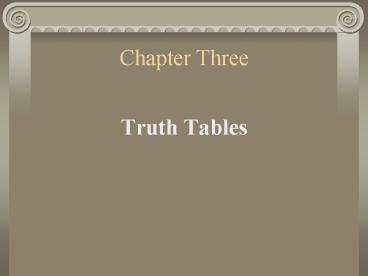Chapter Three - PowerPoint PPT Presentation
1 / 20
Title:
Chapter Three
Description:
Truth Table Test of Validity We can use truth tables to determine if any argument in sentential logic is valid ... All arguments with inconsistent premises are valid. 8. – PowerPoint PPT presentation
Number of Views:92
Avg rating:3.0/5.0
Title: Chapter Three
1
Chapter Three
- Truth Tables
2
1. Computing Truth-Values
- We can use truth tables to determine the
truth-value of any compound sentence containing
one of the five truth-functional sentence
connectives. - This method can also be used to determine the
truth-value of more complicated sentences. - This procedure is called truth table analysis.
3
2. Logical Form
- The assignment of a truth-value to a compound
sentence from the truth-values of its atomic
constituents is called a valuation. - Expressions that contain only sentence variables
and sentence connectives are called sentence
forms. - If we replace sentence variables with sentence
constants we end up with a substitution instance
of the original sentence form. - Logical form is not the same as logical
equivalence.
4
3. Tautologies, Contradictions, and Contingent
Sentences
- A sentence that is true in virtue of its logical
form is a tautology. - Contradictions are sentences that cannot possibly
be true. - The form of a contradiction is a contradictory
sentence form.
5
Tautologies, Contradictions, and Contingent
Sentences, continued
- A contingent statement is one whose form has at
least one T and one F in its truth table.
6
4. Logical Equivalences
- When two statements are logically equivalent, the
truth-value of one determines the truth-value of
the other. That is, each has the same truth-value
under the same truth conditions.
7
5. Truth Table Test of Validity
- We can use truth tables to determine if any
argument in sentential logic is valid. - Recall An argument is valid if and only if it is
not possible for its premises to all be true
while its conclusion is false. - So, if an argument is valid there will be no line
in a truth table in which all the premises are
true and the conclusion false.
8
Truth Table Test of Validity, continued
- We can test an argument for validity by
conjoining the - premises into the antecedent of a conditional,
putting the - conclusion as the consequent, and testing its
form to see if - it is a tautological form. If it is, the
argument is valid.
9
Truth Table Test of Validity, continued
- If the corresponding conditional, or test
statement form, of an argument is a tautology,
then premises are said to logically imply or
entail the conclusion of the argument.
10
Truth Table Test of Validity, continued
- A logical implication is a tautology who main
connective is a horseshoe. - A counterexample is an assignment of truth-values
that will yield true premises and a false
conclusion.
11
6. Truth Table Test of Consistency
- We can use a truth table to check for consistency
by constructing the truth table for the
conjunction of the forms and looking for a line
on which all the substitutions are true. The set
is consistent if and only if there is such a line.
12
7. Validity and Consistency
- The counterexample set of an argument consists of
the premises of the argument together with the
denial of the conclusion. - If the counterexample set is consistent then the
argument is invalid. - All arguments with inconsistent premises are
valid.
13
8. The Short Truth Table Test for Invalidity
- All it takes to show that an argument is invalid
is a single counterexamplea single line of a
truth table on which the premises are all true
and the conclusion false. - It is often possible to produce such a
counterexample by assigning a truth-value to the
entire sentence and then working to find the
appropriate assignment of truth-values to the
atomic constituents.
14
The Short Truth Table Test for Invalidity,
continued
- We find the logical form of the argument, then
assign an F to the conclusion and the try to
assign a T to each premise. - If we can do this the argument is invalid.
15
9. The Short Truth Table Test for Consistency
- All it takes to show that a set of sentences is
- consistent is to produce a single line in a
truth table - that makes them all true.
16
10. A Method of Justification for the Truth Tables
- We can build the truth table for any connective
given the following information - A set of intuitively valid and invalid arguments
- In a valid argument, if the premises are true the
conclusion must be true - In an invalid argument, there must be the
possibility that the premises are true and the
conclusion false
17
A Method of Justification for the Truth Tables,
continued
- To justify a truth table, find valid and invalid
argument forms, using the connective in question,
that force the lines of the truth table.
18
Key Terms
- Contingent statement
- Contingent sentence form
- Contradiction
- Contradictory sentence form
- Corresponding conditional of an argument
- Counterexample of an argument
- Counterexample set
- Logical equivalence
- Logically equivalent
- Logical implication
19
Key Terms, continued
- Logically implies
- Sentence form
- Substitution instance
- Tautologous sentence form
- Tautology
- Test statement form
- Truth table analysis
- Valuation
20
Key Terms, continued
- Truth-function
- Truth-functional operator
- Truth table
- Truth-value
- Wedge
- Well-formed































